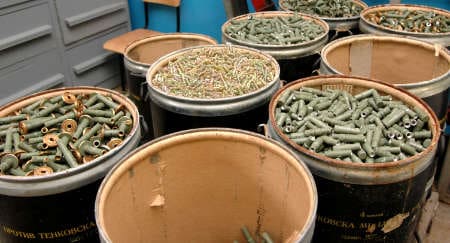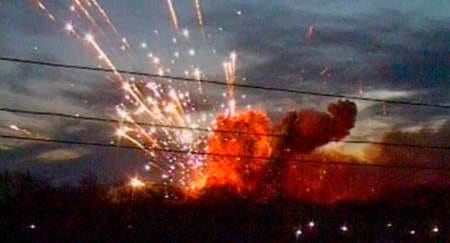David Towndrow and Fred Peugeot of NATO’s agency dealing with the dangers of small arms and light weapons outline progress so far and challenges ahead
During its 50 years of political isolation in the 20th century, Albania amassed massive stockpiles of weapons and ammunition in response to perceived threats to its security. But in 1997, during widespread civil unrest, more than 600,000 weapons and thousands of tonnes of ammunition were looted from dispersed storehouses.
The danger came not just from theft and looting, but from inadequate storage safety. Since 1997 there had been a number of storehouse incidents, including explosions caused by the degradation of the ammunition itself. Nothing illustrated this danger more than the March 2008 Gërdec disaster.
An ammunition demilitarisation programme had been allowed to develop with inadequate oversight or safety controls. A major explosion destroyed the facility and severely damaged inhabited buildings nearby. Some 26 people were killed, more than 300 were injured and widespread damage occurred with significant clean-up costs that are still ongoing today.
Albania is now a NATO member and, like some other members, its forces continue to experience the challenge of modernisation. Over the past decade a significant quantity of ammunition had been destroyed or sold. But by 2009, around 85,000 tonnes of excess or obsolete munitions still remained largely to be processed for destruction.
In early 2011 a NATO project began to help Albania demilitarise around 24,000 tonnes of munitions over four years
In early 2011 a NATO project, funded principally by a $10 million commitment from the US State Department, began in Albania. The project will help the country develop its main industrial demilitarisation factory at Mjekes and will demilitarise around 24,000 tonnes of munitions over four years.
NATO has been playing a major role in trying to help destroy these weapons and munitions in a number of countries other than Albania. Over the past decade in Albania alone, NATO Trust Fund projects helped to destroy 1.6 million anti-personnel mines in 2001-2 and a second project in 2003-2007 destroyed 11,500 tonnes of small arms and light weapons (SALW) including 2 million hand grenades and 130,000 mortar rounds. These successes, brought about by mulitlaterally funded projects, help NATO to improve regional safety issues.
The role of NAMSA
NATO engagement has been focussed through the NATO Maintenance and Supply Agency (NAMSA) based in Luxembourg. NAMSA manages large demilitarisation programmes on behalf of NATO members, and this led to the agency becoming the managing agent for similar programmes through the NATO Trust Fund.
The NATO Trust Fund policy, developed in September 2000, first aimed at supporting nations having to destroy stockpiled anti-personnel landmines within 4 years of their ratification of the Ottawa Treaty.
While as a NATO Partner nation in 2001, Albania was the first to benefit from this new policy. The NATO Trust Fund provided the financial resources, NAMSA provided the project management, contracting and financial control, and the host countries provided engineering skills and labour.
Other countries, such as Ukraine, Moldova, Tajikistan, Belarus or Serbia and Montenegro saw more than 4 million stockpiled anti-personnel landmines destroyed. This contributed to the Balkans becoming the world's first region free of stockpiled anti-personnel mines.
Recognising the importance of a UN resolution on the eradication of illicit trade in small arms and light weapons, the NATO Trust Fund policy was modified in 2001 to incorporate SALW assistance projects. Following this, Serbia, Montenegro, as well as Albania saw the destruction of more than 100 million small arms ammunition cartridges and Ukraine saw the destruction of over 400,000 SALW.
The Trust Fund also incorporated international assistance in 2001 on surplus munitions. Albania, Georgia (twice), Ukraine and Moldova have benefitted from projects destroying stockpiled ammunition.
Up to now, 25,000 tonnes of conventional ammunition, 10,000 missiles and rockets and 1,000 MANPADS (shoulder mounted man operated rocket systems) have been destroyed in countries as varied as Albania, Jordan Mauritania and Afghanistan
In Afghanistan, without proper controls, there is a good chance that poorly guarded and inadequately maintained government owned stocks would eventually fall into terrorist hands.
Afghanistan: action where it’s needed
In Afghanistan, minefields, battle areas contaminated by unexploded munitions, arms caches, poorly guarded and inadequately maintained government owned stocks all contribute to its dangerous environment. Without proper controls, there is a good chance that they would eventually fall into terrorist hands.
So what has NATO done to tackle this? The €7 million NATO physical security and stockpile management (PSSM) Trust Fund project set out to build a modern NATO-standard ammunition depot at Chimtallah, in the Kabul region.
Following the September 2006 Afghan-NATO Declaration, which identified ammunition PSSM as one of the key areas of NATO cooperation with Afghanistan, NAMSA was asked to develop a proposal to build a depot to accommodate a large proportion of the stocks required to support the needs of the expanding Afghan National Security Forces (ANSF).
The project started in 2008 and by the time it finished in late 2010, 12 earth covered 'igloos' had been built. An ammunition inspection building and other infrastructure such as roads and security fencing were also built. Fork lift trucks, mechanical handling equipment and ammunition management training were provided to give the ANSF a high capacity depot.
Chimtallah already had 39 earth covered ammunition bunkers, but they were not accessible for mechanical handling equipment and their capacity was limited. Now, two of the new NATO standard igloos can accommodate everything in the existing 39 bunkers.
The United States is now providing even more of these state-of-the-art ammunition storehouses, which should go a long way to completing the storage requirements at the hub of Afghanistan’s ammunition distribution system. Ultimately this will provide secure and safe ammunition storage conditions in the deployed locations of the ANSF throughout the country.
Global solution to a global problem
The most effective way to reduce weapons and munitions stockpiles is by concerted international efforts, regulated by legally binding treaties. The bigger the consensus, the stronger the moral authority, the more difficult it is for states to remain on the outside.
One of the principal strengths of a UN General Assembly resolution or an international treaty is that it acts as a lever for making finance available, particularly for international aid programmes. So it is to be hoped that an international treaty tackling surplus or obsolete ammunition stockpiles will bring about a fundamental re-assessment of this major problem.
Over 10 years, €50 million has been committed to NATO Trust Fund projects by more than 40 NATO Allies and Partner Nations. The European Union, the United Nations Development Programme, the Organisation for Security and Cooperation in Europe and some non-governmental organisations have also contributed to the success of these projects.
While this might be seen a huge investment, international efforts are still insufficient to tackle the issues, particularly for the disposal of excess ammunition stockpiles that remain in large quantities in certain nations .
Despite the best efforts to secure and dispose of obsolete stockpiles originating from the cold war era, much remains to be done. As NATO continues to develop relations with relevant international partners, more opportunities will arise to support destruction efforts worldwide. Until that time, mechanisms like the NATO Trust Fund will continue to provide a necessary vehicle to support such work.



